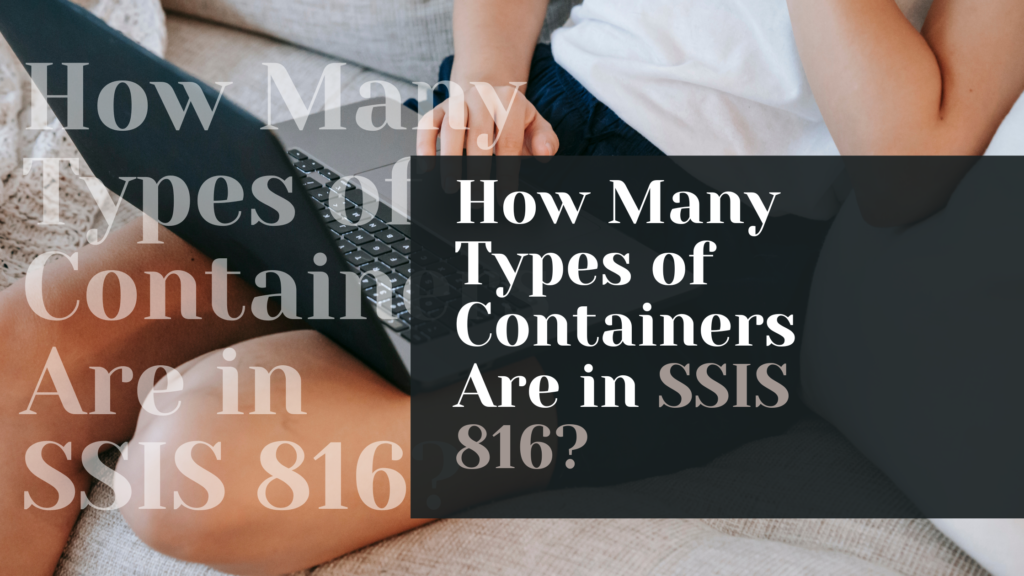In the dynamic world of modern data management, QL Server Integration Services (SSIS 816) emerges as a powerful tool for orchestrating intricate data workflows. Within SSIS, containers play a pivotal role, acting as organizational units that structure tasks and streamline execution flows within packages. These containers provide a systematic approach to managing tasks, enhancing package readability, maintainability, and scalability. This comprehensive article embarks on a journey to uncover the diverse types of containers available in SSIS, shedding light on their functionalities, real-world applications, and the significant role they play in crafting resilient data integration solutions, SSIS 816.
Understanding SSIS Containers
SSIS containers are fundamental components that encapsulate and manage tasks within packages. By grouping tasks into logical units, containers provide a structured framework for controlling the flow of data and operations within SSIS packages. Let’s explore the various types of containers and their unique characteristics:
1. Sequence Container
The Sequence Container acts as a mini-package within an SSIS package, grouping together a sequence of tasks to be executed sequentially. It serves as a fundamental building block for organizing related tasks and simplifying intricate workflows.
Key Features:
- Task Grouping: Organizes related tasks for improved clarity and structure.
- Execution Control: Manages task execution order and provides error handling at the container level.
- Scope Boundary: Defines a scope boundary, allowing variables and parameters to be scoped within the container.
2. For Loop Container
Designed for iterative operations, the For Loop Container enables repetitive task execution based on specified conditions. It offers dynamic control over loop iterations, allowing tasks to be executed multiple times with varying parameters.
Noteworthy Aspects:
- Iterative Logic: Facilitates the implementation of iterative logic within SSIS packages.
- Parameterized Control: Allows for dynamic specification of loop conditions through initialization, evaluation, and iteration expressions.
- Flexible Iteration: Supports various iteration strategies, including incremental looping and looping until a condition is met.
3. Foreach Loop Container
The Foreach Loop Container iterates over a collection of items, executing tasks for each item in the collection. It automates repetitive tasks and handles dynamic sets of items efficiently, making it ideal for scenarios involving file processing, database recordset iteration, and dynamic task execution.
Key Highlights:
- Dynamic Task Handling: Automates repetitive tasks by iterating over dynamic sets of items.
- Collection Iteration: Supports iteration over various collections, such as files in a directory, rows in a database table, or items in an array.
- Parameterized Configuration: Allows for flexible configuration of loop properties through configurable enumerator types.
4. Task Host Container
Though not explicitly visible in the SSIS design surface, the Task Host Container is implicitly created for each individual task added to an SSIS package. It serves as a host environment for tasks, defining the execution context and providing a scope for task-related operations.
Notable Functions:
- Task Hosting: Acts as a host environment for individual tasks, providing the necessary runtime environment for task execution.
- Variable Scope: Defines the scope for variables used within tasks, ensuring variable values are accessible only within the task context.
- Transaction Boundary: Establishes transaction boundaries for tasks, allowing for transactional control over task execution.
Conclusion
In the dynamic landscape n conclusion, SSIS 816 containers are indispensable components for structuring, organizing, and executing data workflows efficiently. Understanding the various container types empowers developers and data engineers to design scalable, maintainable, and resilient ETL processes. By harnessing the diverse capabilities of SSIS containers, organizations can streamline their data integration efforts, unlock the full potential of their data assets, and drive business success. SSIS 816 is a testament to the versatility and effectiveness of these containers in addressing the evolving needs of data integration in today’s data-driven world.
People also search for:
- How Many Ways Are There to Deploy a Package in SSIS?
- Exploring New Tasks and Components in SSIS 816
- The 3 Different Types of Control Flow Elements in SSIS (ssis 816)
- Microsoft SSIS Documentation
- SSIS Tutorials and Resources
FAQs
Q: Can containers be nested within each other in SSIS?
A: Yes, containers can be nested to create complex hierarchical workflows, allowing for granular control over task execution and data flow.
Q: How do containers contribute to the efficiency of SSIS packages?
A: Containers enhance the efficiency of SSIS packages by providing a structured framework for organizing tasks, managing execution flows, and encapsulating reusable logic.
Q: What are some best practices for utilizing SSIS containers?
A: It’s essential to modularize SSIS packages using containers, adhere to naming conventions for better organization, and utilize logging and error handling mechanisms to ensure robustness and reliability.




